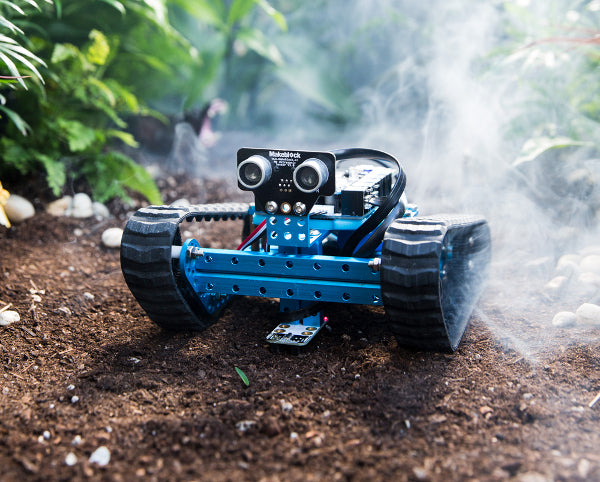What is STEM? | 5 steps to engage kids in STEM

What does STEM stands for?
You might already know that STEM is an acronym for science, technology, engineering ,and math. However, it isn‘t just one discipline, but rather the combination of all these four overlapping disciplines.
As shown in the above picture, block coding has colorful blocks and shows different functions. One kind of color stands for one kind of function. For example, in the above block coding program, the light blue blocks are for the instructions for the "sensors". This displaying feature is helpful for kids and beginners who are not very familiar with the functions of each block to get started. And the color classification made it much easier to drag, drop and combine different blocks to build instructions.
Take Scratch Coding as an example. There are 10 colors for 10 blocks: Motion, Appearance, Sounds, Events, Controls, Sensors, Operators, Variables, Lists, and My Blocks.
Further understanding of STEM meaning
STEM is like a toolbox full of smaller toolsets for designing and making things. Image that there is a carpenter‘s toolbox, in which you can find sets of drill bits, rachets and wrenches, chisels , and other useful gadgets. Similarly, STEM disciplines are like those little toolsets. Each is helpful in its own right, but most activities require more than one.
Why STEM is good to kids?
1. Kids could develop and gain a set of core skills they will need as they grow up.
1) Problem-solving skill
STEM allows kids to develop their problem-solving skills as kids would try to examine problems and come up with solutions to tackle the issue.
2)Creativity
Children could also think out of the box via STEM because not only will they try to think of new ideas and innovations but also gain inspiration from their teammate.
3) Collaboration
Team projects, especially in STEM projects, allow students to collaborate on complicated problems and form valuable communication or interpersonal skills
4) Critical and strategic thinking
Learning to question is part and parcel of critical and logical thinking. Once a new concept is mentioned or introduced, it will promote them to prove their thinking through endless asking, experimenting and trying.
5) Intellectual curiosity
STEM helps inspire exploration, and imagination and drives kids to discover new answers. That is to say, their spark of wonder is ignited. The more they accept failure, the sweeter success will make them feel after several failures.
6) Self-confidence
Endless failure and experiments will teach students to learn from failure.
2. STEM gives kids the chance to have fun when learning something new.
Many children perceive STEM as dull or intimidating, which hampers their learning enthusiasm. In fact, utilizing interactive tools such as coding robotics or educational apps could tap into children’s curiosity through playing games. Thus, kids will view STEM as an adventure rather than a chore.
3. STEM brings many exciting subjects that can lead to fulfilling career opportunities for young people.
In STEM fields, there are quite a lot of high-paying jobs that require kids who study STEM can build the foundation required to pursue degrees in high-level income fields such as medical doctors, dentists, scientists , and so on..
How to engage kids in STEM?
Step 1:Let kids experiment with different materials
STEM activities work best when kids use a variety of material. For example, you could let them draw a city map using crayons of different colors. Inspire your kids to code a smart robot that can recognize the color and then change its speed.
Step 2:Keep it fun and safe
.When kids have fun, they are motivated and encouraged to keep studying STEM. Even when the project or activity is difficult and challenging. Make sure that any STEM project is age-appropriate and safe for your child to do independently.
Step 3:Encourage STEM activities with friends and family
Through stem activities as a family, you will leave unforgettable memories and boost the teamwork
Step 4:Use STEM to teach every day
Here we give three STEM teaching methods, namely, Project-based learning, Problem-based, and Inquiry-based learning. Project-based learning encourages students to learn skills and apply their knowledge by participating in a project. They need to work for an extended period and create a solution to a problem. Problem-based project is somehow similar to project-based learning, but the key difference is that kids must analyze and evaluate a problem. While inquiry-based learning pushes kids to ask as many questions as they like surrounding the subject matter.
Step 5:Introduce and bring your kids to different international competitions such as the MakeX Robotics Competition.
The benefits of STEM competitions include opportunities for students to think critically and work together in a team.
Now, since you have successfully mastered how to engage your kids in STEM. It’s time to figure out how to integrate these STEM skills into a kid’s life. You can give your children following robotic kits through exploring physics, engineering ,and other topics by assembling small machines, encouraging them to engage in STEM.
1. mBot2

mBot2, as a constructable coding robot kit, is suitable for children aged 6(+). It exerts positive effect on kid‘s creativity and initiative as kids could customize mBot2 with LEGO bricks, electronics modules, and add-on packs. Its 5-hour battery life supports long-term use, and enables kids to have endless fun. The easy-to-learn guidelines enable children to learn coding from block-based to Python without much difficulty. Multi-functions are proved by its remote control, voice control, line following, IoT, etc.
2. mBot Ranger

mBot Ranger is the best choice for children whose age is 8(+) . Whether kids are beginners or not, they could learn coding languages including Scratch and Arduino C with the assistance of 16 coding & robotics cases in the Makeblock Help Center. Kids can enjoy different kinds of hands-on activities by using free apps and resources. There are 3 building forms to explore: robot tank, self-balancing robot, and racing car. This multiform robotics kit could overcome outdoor activities such as grassland gravel, and sandy beach.
3. mBot Ultimate

mBot Ultimate aims at helping students especially those who are over 12 with engineering, mechanical, and programming learning. Makeblock Help Center provides more than 17 coding & robotics cases for mBot Ultimate. Not only does it support visual programming such as Scratch block-based programming, the Arduino IDE, and Python, but also it works well together with both Arduino and Raspberry Pi.

